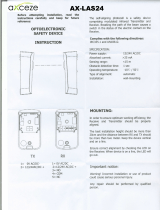ENFORCER E-964-Q660Q is a quad-photobeam detector with an impressive 660 ft. (200m) outdoor range and 1320 ft. (400m) indoor range. It features four selectable beam frequencies to eliminate interference between multiple units, ensuring enhanced perimeter protection. The built-in heater and environmental control output prevent false alarms in challenging weather conditions. Installation is simplified with the laser and visual alignment systems, making it suitable for applications requiring long-distance protection.
ENFORCER E-964-Q660Q is a quad-photobeam detector with an impressive 660 ft. (200m) outdoor range and 1320 ft. (400m) indoor range. It features four selectable beam frequencies to eliminate interference between multiple units, ensuring enhanced perimeter protection. The built-in heater and environmental control output prevent false alarms in challenging weather conditions. Installation is simplified with the laser and visual alignment systems, making it suitable for applications requiring long-distance protection.






-
 1
1
-
 2
2
-
 3
3
-
 4
4
-
 5
5
-
 6
6
ENFORCER E-964-Q660Q Installation guide
- Type
- Installation guide
- This manual is also suitable for
ENFORCER E-964-Q660Q is a quad-photobeam detector with an impressive 660 ft. (200m) outdoor range and 1320 ft. (400m) indoor range. It features four selectable beam frequencies to eliminate interference between multiple units, ensuring enhanced perimeter protection. The built-in heater and environmental control output prevent false alarms in challenging weather conditions. Installation is simplified with the laser and visual alignment systems, making it suitable for applications requiring long-distance protection.
Ask a question and I''ll find the answer in the document
Finding information in a document is now easier with AI
Related papers
-
 ENFORCER SS-078Q Installation guide
ENFORCER SS-078Q Installation guide
-
 ENFORCER E-9679C8B25Q Installation guide
ENFORCER E-9679C8B25Q Installation guide
-
SECO-LARM E-960-D90GQ Owner's manual
-
 ENFORCER SD-7201GAPT1Q Installation guide
ENFORCER SD-7201GAPT1Q Installation guide
-
 ENFORCER SD-7202BC-HC Installation guide
ENFORCER SD-7202BC-HC Installation guide
-
 ENFORCER E-964-S50TB Installation guide
ENFORCER E-964-S50TB Installation guide
-
SECO-LARM S0090 Owner's manual
-
 ENFORCER E-960-D90Q Installation guide
ENFORCER E-960-D90Q Installation guide
-
 ENFORCER SA-026Q Installation guide
ENFORCER SA-026Q Installation guide
-
 ENFORCER SD-9963-KSGQ Installation guide
ENFORCER SD-9963-KSGQ Installation guide
Other documents
-
SECO-LARM ENFORCER E-964-Q660Q Owner's manual
-
 Axceze AX-LAS24 Datasheet
Axceze AX-LAS24 Datasheet
-
SECO-LARM SK-919TT1S-BU Datasheet
-
321 Studios Enforcer SA-026 User manual
-
SECO-LARM E-960-D90Q Owner's manual
-
SECO-LARM E-960-D90GQ Owner's manual
-
SECO-LARM SLI ENFORCER SA-025MQ Owner's manual
-
 SASO PB030-S,PB060-S User And Installer Manual
SASO PB030-S,PB060-S User And Installer Manual
-
SECO-LARM SD-9963-KSGQ Owner's manual
-
SECO-LARM SD-7098-SKDQ Owner's manual















